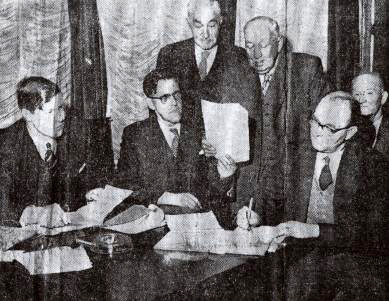|
 The
Photograph shows a Manor of Brierley Court Leet meeting on 1st
November 1961. On the left seated George Michael Foljambe, stood up
on the left is Thomas Moxon (b.1877) who is next to Arthur
Hargreaves The
Photograph shows a Manor of Brierley Court Leet meeting on 1st
November 1961. On the left seated George Michael Foljambe, stood up
on the left is Thomas Moxon (b.1877) who is next to Arthur
Hargreaves
Photograph reproduced from an old newspaper
cutting.
'Then
comes the task of appointing "byelaw men and pinders" responsible for
ensuring that the laws relating to the use of the local common lands are
observed.
'One young
farmer, attending his first court following taking over the farm, demurred
somewhat when he was nominated and asked what the duties entailed. It was
pointed out to him, a little sadly, I thought, that only in the unlikely
event event of some unauthorised person turning their livestock on to the
common to graze would he be required to assert his authority.
'As I have already
said, the duties of the Brierley Court are now reduced to caring for the
local commons upon which, according to the deeds of his property, each
member has the right to graze so many cattle, or geese, or donkeys.
'Now it is usually a
matter of confirming an application for a way leave over the common land
(permission to enter) and here it is interesting and not a little
ironical, to find two of the innovations, the Coal Board and the
Electricity Board, coming, almost cap in hand, to make applications to
this relic of feudalism.
'Generally, the
atmosphere of the meetings of the Court Leet is cordial, although several
of the common lands have been let of for farming - a development of the
last war, when every acre of land put under food cultivation was valuable
- a little acrimony has crept in with regard to what happens to the
revenue from the leasing of the land.
'There is a school of
thought that the court members (they are called "commoners", by the way),
having lost some of their grazing rights., should receive some of the
income by way of compensation. Leading advocates of this old school is
`old Arthur Hargreaves (see photograph) who farms at Shafton and who, with a temerity
which, I am sure, would have had his forebears quaking in their shoes,
repeatedly tells the Lord of the Manor. or his Steward, that "the
commoners are being done down",
'His suggestion is
that the revenue used to provide the commoners with the same "Goodly
Feast" that used to mark the closure of the court. Arthur has been a
member long enough to have personal recollection of the feasts, with
tables groaning with a baron of beef and plenty of whisky and rum - at 2d
a tot by the way - and beer at three ha'pence a pint. He agrees with the
song that "Things ain't what they used to be," and takes a poor view of
the pickles and sandwiches that are now dispensed.
'To attend the Court
brings home to one just how much times have changed, for a man who warned
his tenants about missing one of his meetings "at their peril", would
certainly have had a quick way of dealing with such recalcitrants as
Arthur.
Sadly, the Court Leet
of the Manor of Brierley is no longer held at the Three Horse Shoes. My
search for its records via the internet led me to Nottingham University
Library's Department of Manuscripts and Special Collection, where the
papers of the Monckton-Arundell Family, Viscounts Galway of Serby Hall,
Nottinghamshire, (early 13th century -1958) are held. Access to the 20th
century records is restricted. In addition, Sheffield Archives have the
Court Rolls for 1656-60 as part of the Spencer Stanhope Muniments.
Manorial records are
stored in a wide variety of places. Many can be located online by looking
at The National Archives website
www.archiveshub.ac.uk/, or
the access to Archives website
www.nationalarchives.gov.uk/a2a.
Readers who are
interested in learning more about the court leet and baron will find a
good summary in Mark Herber's book Ancestral Trails, published by
Sutton.
'Footnote.
There is a transcription of a 1655 Brierley Manor Court Roll on the
Brierley Yorkshire England web site at
http://www.brierleyyorkshireengland.com in
the on
line booklet ‘Brereley a History of Brierley'. Many of
the court rolls for Brierley Manor are in the Savile of Rufford
manuscripts at Nottingham County Record Office. Some copies
may be loaned from Richard
Watson (please see the
Ask Richard link)).
The Galway Manuscripts mentioned are for the estates of
Hodroyd Hall Felkirk.'
|